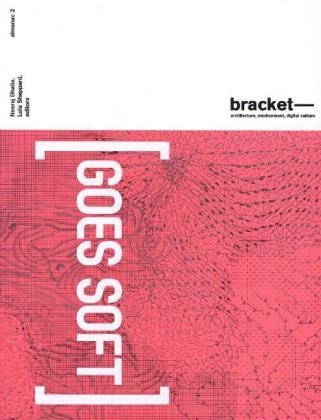Read more
Eine detaillierte Untersuchung von Soft Systems im Design
Bracket ist eine Buchreihe, die sich mit wichtigen aufkommenden Themen an der Schnittstelle von Architektur, Umwelt und Digital Culture beschäftigt. In einer Zeit der erklärten Krise wirtschaftlich, ökologisch, klimatisch hat das Konzept Soft Systems eine zunehmende Bedeutung als Gegenmodell zu dauerhaften, statischen und harten Systemen erhalten. In Anerkennung von veränderlichen und unbestimmten Situationen mit komplexen Rückkopplungsschleifen, die Reaktion und Anpassung erlauben, hat das Potential von Soft Systems in den Bereich des Design Eingang gefunden. Die Beispiele, die in Bracket 2 gezeigt werden, bieten einen kleinen Katalog von Soft Systems einige vor allem architektonische, geologische und weitere gänzlich metaphorische Systeme. In allen Fällen untersuchen diese Beispiele, wie sich der Begriff "going soft" über Berufe, Disziplinen und Forschungsfelder hinweg wiederholt. Das Buch ist in folgende Themenbereiche gegliedert: sensing/feedback ; interfacing/enveloping ; subverting/hijacking ; formatting/distributing ; contingency/resilience ; diffusing/generating . Von weicher Politik, weicher Macht und weichen Räumen zu flüssigen Territorien, Software und weichem Programmieren setzt sich Bracket 2 mit dem Gebrauch und der Funktion von reaktionsfähigen, unbestimmten, flexiblen und immateriellen Systemen im Design auseinander. Die Redaktion und Jury für Bracket 2 besteht aus Julia Czerniak, Jeffrey Inaba, Geoff Manaugh, Philippe Rahm, Charles Renfro sowie den Mitherausgebern Neeraj Bhatia und Lola Sheppard.
Eine Zusammenarbeit von InfraNet Lab und Archinect.
From soft politics, soft power and soft spaces to fluid territories, software and soft programming, Bracket 2 unpacks the use and role of responsive, indeterminate, flexible, and immaterial systems in design. In an era of declared crises economic, ecological and climatic, among others the notion of soft systems has gained increasing traction as a counterpoint to permanent, static and hard systems. Acknowledging fluid and indeterminate situations with complex feedback loops that allow for reaction and adaption, the possibility of soft systems has reentered the domain of design. The examples displayed in Bracket goes soft are offered as nothing more than a short catalog of soft systems some explicitly architectural, others geological, others entirely metaphorical. In all cases, these examples explore how the notion of going soft can be iterated across professions, disciplines, and fields of research. The book is divided into the themes sensing/feedback ; interfacing/ enveloping ; subverting/hijacking ; formatting/ distributing ; contingency/ resilience ; diffusing/generating . Bracket is a book series structured around an open call that highlights emerging critical issues at the juncture of architecture, environment, and digital culture. The editorial board and jury for Bracket 2 includes Benjamin Bratton, Julia Czerniak, Jeffrey Inaba, Geoff Manaugh, Philippe Rahm, Charles Renfro, as well as co-editors Neeraj Bhatia and Lola Sheppard. Bracket is a collaboration between InfraNet Lab and Archinect.
About the author
Neeraj Bhatia received his Masters degree in Architecture and Urban Design from MIT where he was studying on a Fulbright Fellowship. His thesis research focused on the design of public libraries in infrastructural landscapes and was awarded the thesis prize. Prior to that, he attended the University of Waterloo where he obtained a pre-professional (B.E.S) and professional degree (B.Arch) in Architecture. His B.Arch thesis was awarded a thesis prize and two awards of excellence from the OAA. Amongst other offices, he has worked for Eisenman Architects, Coop Himmelblau, Bruce Mau Design, OMA, ORG and Lateral Office. He has taught at the University of Waterloo and the University of Toronto, and been a guest reviewer at Harvard GSD, MIT, Wentworth Institute of Technology, Ryerson University and the University of Waterloo. His research has been published in Volume/Archis, Thresholds, Footprint, Onsite Review, brkt, and Yale Perspecta. He is co-editor of ,Arium: Weather + Architecture' (with Jürgen Mayer H., Hatje Cantz Publishing, 2009), a research guide examining the relationship of building and weather. In 2008, Neeraj became a director of InfraNet Lab, a non-profit research collective probing the spatial byproducts of contemporary resource logistics. InfraNet Lab's research into urban infrastructures will be published in Pamphlet Architecture 30.

